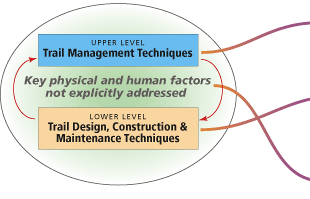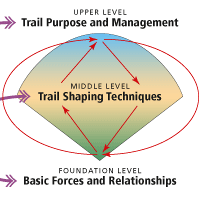

|
|
|
 |
Technique-based elements transform into process-based elements:
|
| Note that the new system both incorporates and transforms the technique-based levels: |
 |
Many of the key physical and human issues not explicitly addressed in the technique-based system become the Foundation Level—an integral part of the process—in the process-based system. Others |
 |
Trail design, construction, and maintenance techniques are basically similar in both systems, with one major difference. In the new system, this level is entirely based on the basic forces and relationships of the Foundation Level. In other words, trail shaping techniques are directly based on what actually happens with humans, nature, and trails in the real world. And—by tightly linking techniques to their base forces—we can improve efficiency, improve sustainability and enjoyability, and often reduce cost/effort of trail design, construction, and maintenance. |
 |
Trail management techniques are relatively similar in both systems, but the new system uses the new Foundation Level to great advantage. The Foundation Level tells us much about how people perceive, enjoy, and use nature and trails. This info greatly informs trail management by highlighting the recreational aspect of trails; guiding us to maximize the trail experience given the site, vistitors, and budget; helping us understand the dynamics of trail use; emphasizing the value of "aesthetics" and trails; tightly linking trail shaping techniques (structure) with trail management such that structure supports management; and more. |


